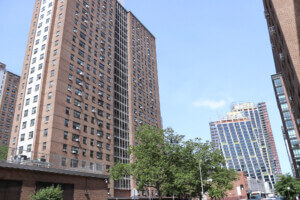Yesterday, publicity firm Hello Human, designer Stephen Burks, and curatorial and events company Anava Projects called out the Campo Base exhibition, a display at Milan Design Week’s fuorisalone event that featured “racist figurines.” The overall show was curated by Federica Sala, who invited contributions from six designers. The Il Collezionista (The Collector) section was designed by Italian architect Massimo Adario and artist Andrea Sala and included the offending objects.
Il Collezionista features a series of figurines manufactured in the 1920s arranged on shelves in a glass vitrine. Hello Human founder Jenny Nguyen, who visited the show last Wednesday, said in a statement: “I was shocked when I first saw the glass figure depicting a stereotypical Black character and as I walked around the glass cabinet I realized there were more characters each representing stereotypical versions of a broad spectrum of minority cultures – Asian, Middle Eastern, Indigenous, Pacific Islander etc.as I walked around the glass cabinet I realized there were more…”
View this post on Instagram
Since Hello Human, Burks, and Anava put out statements condemning the display, Adario has publicly apologized. In a statement shared with Dezeen today, he said “It was absolutely not my intention to inflict harm nor offense.” He continued: “I invite anyone who has suffered to engage with me to help me understand the different worlds and cultures from which each of us comes in the belief that only knowledge and empathy are the true antidote to racism.”
Campo Base was conceived as a “utopia” designed by Italian design studios and described itself as “a manifesto on contemporary interior design,” according to press materials. Il Collezionista, installed in a rectangular room, staged a showcase of objects at the center and located seating around the perimeter. The room is partially enclosed by a tent that opens to a projection of the sky that is livestreamed from Adario’s apartment. Campo Base’s press kit describes the intended mood as “cozy and abstract.”
Press text further described the display case, and its contents, as a compilation of objects amassed “by a hypothetical collector, Kaspar Ulz, the custodian of a vast collection of Meissen porcelain, protagonist of the latest novel by Bruce Chatwin, published in 1988.”
As Nguyen further noted, Campo Base was repeatedly marketed as a “must see” event of Milan Design Week by design media. Preview articles of the exhibition did not take note of the objects’ racist undertones; several of these articles have since been updated to reflect the outcry from Nguyen, Burks, and others in the design community condemning the display. The press kit included photography of Adario and Sala’s work; one of the figurines is visible in an image.
Hello Human, Burks, and Avana Projects published an Instagram post distilling their statement and sharing their photos of the objects. Nguyen said that “we made a choice not to tag and call out the designer and the curator on Instagram because we didn’t want this to become a witch hunt.” The group sees the post as a way to generate conversation within the industry and “look at ways we can level the playing field for BIPOC folks.”
Nguyen’s statement clarified that many of the European attendees that she spoke with did not take issue with the display. She acknowledged in her statement that “the topic of racism is not discussed as widely in Europe as it is here in the US.”
Burks, who leads the design studio Stephen Burks Man Made, added: “The unfortunate message this exhibition has sent is that people of non-European origin do not have the right to exist outside of a Eurocentric, often racist, frame of reference. We must acknowledge that the historical objects on display in the exhibition originated from violence. We must understand how their creation in the 1920’s was derived from an unequal system of cultural exploitation borrowing directly from European colonial practices of dehumanizing ‘othering.’”
The design industry—and particularly that of Italy—is not new to criticism over its racist practices. Prior backlashes included articles about the near-total dominance of white furniture designers and racist clothing items coming from Italian fashion houses.
“Design is popular culture and our actions shape attitudes and opinions that reflect where we are as a society,” Burks stated. While Adario did apologize, further conversation is required to actively address problematic histories, tropes, and objects within the wide disciplines of architecture and design. As Burks summarized, “Where we go from here is of critical importance.”











